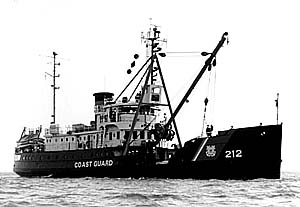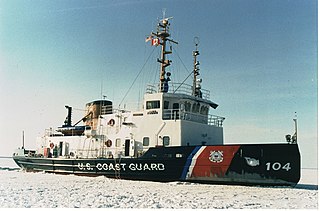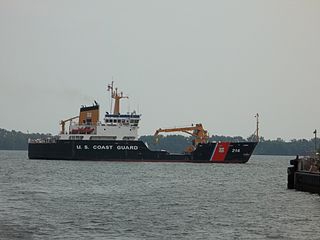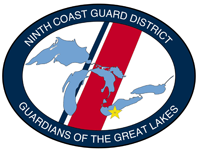
USS Edisto (AGB-2) was a Wind-class icebreaker in the service of the United States Navy and was later transferred to the United States Coast Guard as USCGC Edisto (WAGB-284). She was named after Edisto Island, South Carolina. The island is named after the Native American Edisto Band who inhabited the island and the surrounding area. As of 2011 there is a namesake cutter USCGC Edisto (WPB-1313). The newer Edisto is a 110-foot Island-class patrol boat and is stationed in San Diego County, California.

The USCGC Acacia (WAGL-406/WLB-406) is an Iris-class 180-foot seagoing buoy tender operated by the United States Coast Guard. Acacia was a multi-purpose vessel, nominally a buoy tender, but with equipment and capabilities for ice breaking, search and rescue, fire fighting, logistics, oil spill response, and other tasks as well. She spent almost all of her 62-year Coast Guard career on the Great Lakes. After decommissioning she became a museum ship in Manistee, Michigan.

USCGC Northwind (WAG/WAGB-282) was a Wind-class icebreaker, the second United States Coast Guard Cutter of her class to bear the name. She was built to replace USCGC Staten Island which was in Soviet lend-lease service.

USCGC Mackinaw (WLBB-30) is a 240-foot (73 m) multi-purpose vessel with a primary mission as a heavy icebreaker specifically built for operations on the North American Great Lakes for the United States Coast Guard. IMO number: 9271054.

The United States Coast Guard Cutter Fir was the last lighthouse tender built specifically for the United States Lighthouse Service to resupply lighthouses and lightships, and to service buoys. Fir was built by the Moore Drydock Company in Oakland, California in 1939. On 22 March 1939, the U.S. Lighthouse Tender Fir was launched. She was steam driven with twin screws, 175 feet (53 m) in length, had a beam of 32 feet (9.8 m), drew 11 feet 3 inches (3.43 m) of water, and displaced 885 tons. Fir was fitted with a reinforced bow and stern, and an ice-belt at her water-line for icebreaking. She was built with classic lines and her spaces were lavishly appointed with mahogany, teak, and brass. The crew did intricate ropework throughout the ship. The cost to build Fir was approximately US$390,000. Fir's homeport was Seattle, Washington for all but one of her fifty one years of service when she was temporarily assigned to Long Beach, California when USCGC Walnut was decommissioned on 1 July 1982.

USCGC Swivel (WYTL-65603) was one of fifteen 65-foot steel-hulled harbor tugs, that entered service with the United States Coast Guard in the 1960s. Each was built to replace the 64-foot wooden-hulled harbor tugs built during the 1940s.

Coast Guard Station Sturgeon Bay is a United States Coast Guard station located on Lake Michigan and the Sturgeon Bay Ship Canal in the Town of Sturgeon Bay in Door County, Wisconsin, just outside the city of Sturgeon Bay. The Sturgeon Bay Canal Light is located within the limits of the station. Duties of the station include search and rescue, law enforcement and ice rescue missions during the winter months.

USCGC Biscayne Bay (WTGB-104) is a United States Coast Guard Cutter and an icebreaking tug. She is based at Coast Guard Station St. Ignace with a primary area of operation in the Straits of Mackinac including Mackinac Island, Mackinac Bridge, and the northern portions of Lakes Michigan and Huron and occasionally Lakes Superior, Erie and their connecting rivers. Beyond her role as an icebreaker, Biscayne Bay performs search and rescue and law enforcement functions.

USCGC Woodrush (WLB-407) was a buoy tender that performed general aids-to-navigation (ATON), search and rescue (SAR), and icebreaking duties for the United States Coast Guard (USCG) from 1944 to 2001 from home ports of Duluth, Minnesota and Sitka, Alaska. She responded from Duluth at full speed through a gale and high seas to the scene of the SS Edmund Fitzgerald sinking in 1975. In 1980, she took part in a rescue rated in the top 10 USCG rescues when she helped to save the passengers and crew of the cruise ship Prinsendam after it caught fire in position 57°38"N 140° 25"W then while being towed sank off Graham Island, British Columbia. She was one of the first vessels to respond to the Exxon Valdez oil spill in 1989. She was decommissioned on 2 March 2001 and sold to the Republic of Ghana to serve in the Ghana Navy.
USCGC Tupelo WAGL/WLB-303, was a Cactus (A) Class 180-foot buoy tender vessel built by Zenith Dredge Company of Duluth, Minnesota. Her keel was laid 15 August 1942, launched 28 November 1942 and commissioned on 30 August 1943. She was built as a WAGL and redesignated a WLB in 1965.
USCGC Catenary (WYTL-65606) was a cutter in the United States Coast Guard (USCG). Constructed by the Gibbs Gas Engine Company and commissioned in early 1962, the vessel served as part of the USCG for over 30 years before being decommissioned in mid-1995 and sold to the United States Merchant Marine Academy. During her service Catenary was based primarily on the east coast of the United States where she was utilized mainly in a law enforcement role.

USCGC Hollyhock (WLB-214) is a 225-foot (69 m) Juniper-class cutter of the United States Coast Guard.
USCGC Bitt (WYTL-65613) was a cutter in the U.S. Coast Guard. Constructed by Western Boat Building Corp and commissioned in 1966, the vessel served as part of the USCG for sixteen years before being decommissioned in 1982 and transferred to the National Science Foundation (NSF). During her Coast Guard service, Bitt was based in Washington and Alaska, where she was utilized mainly in a law enforcement and search and rescue (SAR) role. She was purchased by a civilian couple living and raising their first child aboard the vessel.

The USCG 65' small harbor tug is a class of fifteen tugs used by the United States Coast Guard for search and rescue, law enforcement, aids-to-navigation work and light icebreaking. The tugs are capable of breaking 18 in (0.46 m) of ice with propulsion ahead and 21 in (0.53 m) of ice backing and ramming. They were designed with steel hulls to replace the 64 ft (20 m) wooden-hulled tugs that had been in service since the 1940s and were built by Gibbs Gas Engine Company, Jacksonville, Florida; Barbour Boat Works of New Bern, North Carolina; and Western Boat Builders Corporation, Tacoma, Washington from 1961 to 1967. They were originally powered by a single 400 horsepower diesel engine, however several have been re-powered with 500 horsepower main drive engines since they were constructed.

District 9 is a United States Coast Guard district, based at the Anthony J. Celebrezze Federal Building, in Cleveland, Ohio. District 9 is responsible for all Coast Guard operations on the five Great Lakes, the Saint Lawrence Seaway, and surrounding states accumulating 6,700 miles of shoreline and 1,500 miles of international shoreline with Canada.

The following January 2019 order of battle is for the United States Coast Guard.

USCGC Bristol Bay (WTGB-102) is the second vessel of the Bay-class tugboats built in 1978 and operated by the United States Coast Guard. The ship was named after the body of water formed by the Alaskan peninsula, which emptied into the Bering Sea.

USCGC Neah Bay (WTGB-105) is the fifth vessel of the Bay-class tugboat built in 1980 and operated by the United States Coast Guard. The ship was named after a bay located within the state of Washington and bordered by Puget Sound.

USCGC Morro Bay (WTGB-106) is the sixth vessel of the Bay-class tugboats built in 1980 and operated by the United States Coast Guard. The ship was named after a seaside city in San Luis Obispo County, California.

USCGC Thunder Bay (WTGB-108) is the eighth vessel of the Bay-class tugboat built in 1985 and operated by the United States Coast Guard. The ship was named after a bay in the U.S. state of Michigan on Lake Huron. She is homeported in Rockland, Maine
















